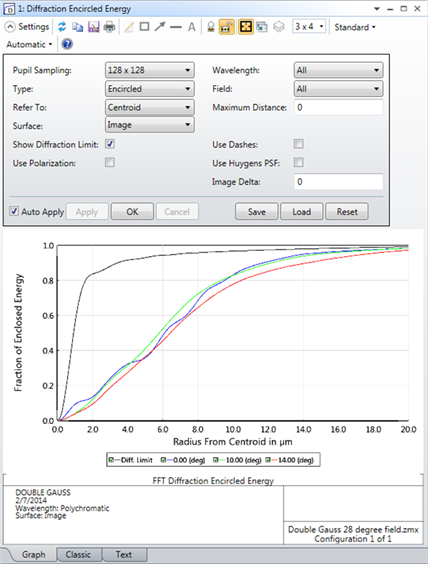Encircled energy diagram. This is the percentage of total energy enclosed as a function of distance from either the chief ray or the image centroid at the image of a point object.

Sampling The size of the ray grid used to sample the pupil. The sampling may be 32x32, 64x64, etc. Although higher sampling yields more accurate data, calculation times increase.
Type The analysis type option specifies how the encircled energy is calculated; either encircled (radial), X-only, Y-only, or ensquared.
Maximum Distance This setting overrides the default scaling. The units are micrometers. To choose the default scaling option, enter zero.
Use Dashes Selects either solid lines or dashed lines to differentiate the various curves.
Refer To Select chief ray, centroid, or vertex as the reference point. Vertex refers to the coordinates (0, 0) on the image surface. This option will only return meaningful data if the diffraction image at all selected fields is within the maximum distance of the vertex. When vertex is selected, OpticStudio is unable to detect if the sampling is sufficient, so some care should be taken to set the sampling high enough for accurate results.
Surface Selects the surface at which the data is to be evaluated. This is useful for evaluating intermediate images. See “Evaluating results at intermediate surfaces”.
Wavelength The wavelength number to be used in the calculation.
Field The field number for which the calculation should be performed.
Show Diffraction Limit If checked, the diffraction limited results are computed and displayed. See the discussion below.
Use Huygens PSF If checked, the more accurate but slower Huygens PSF method is used to compute the PSF. This option should always be used if the image surface is tilted, or if the chief ray is not close to normal to the image surface.
Image Sampling If "Use Huygens PSF" is checked, this control allows a user selectable image sampling grid. The default setting will select a grid that is 2X larger in each direction than the pupil sampling grid.
Image Delta This control selects the point spacing on the image grid in micrometers. Use zero for the default image delta.
Use Polarization If checked, polarization is considered. See ”Polarization (system explorer) for information on defining the polarization state and how polarization is used by analysis features.
Discussion
See the discussion sections of the FFT and Huygens PSF. Those comments also apply to this feature.
The accuracy of the diffraction encircled energy calculation is limited by the magnitude and slope of the OPD error and the sampling density used. If the sampling density is insufficient, OpticStudio will issue an error message indicating that the data is inaccurate. To increase the accuracy, increase the sampling density or decrease the OPD error. If shown, the diffraction limit curve is for the aberration free response at the reference field position (see “Diffraction Limited” in the chapter “Conventions and Definitions“)
For systems with low OPD error, finite energy can exist in the PSF out to long distances from the image centroid. For such systems, it can be computationally challenging to track energy accurately over both small (within the Airy radius) and large distances. When using low sampling, results can be subject to error in those cases. For such systems, higher sampling is generally required for accurate results over the full range of the PSF.
The X- and Y-only options compute the fraction of energy in the PSF in the [-y,y] or [-x,x] range of the y- or x-axes, respectively, centered on the chosen reference point. For example, the X-only enclosed energy for an x-value of 10 microns represents the fraction of energy in the region 20 microns across in the x-direction, centered on the reference point, and infinite in the other direction.